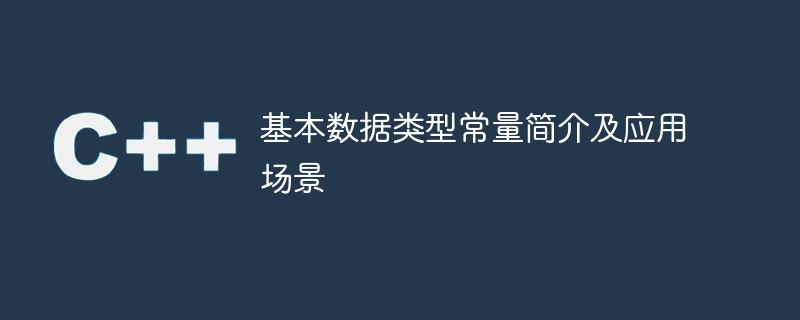Home >Backend Development >C++ >Overview and use cases of basic data type constants
Overview and use cases of basic data type constants
- WBOYWBOYWBOYWBOYWBOYWBOYWBOYWBOYWBOYWBOYWBOYWBOYWBOriginal
- 2024-01-05 12:52:201259browse

Title: Introduction to basic data type constants and application scenarios
Introduction:
In computer programming, basic data types are one of the foundations for building programs. Constants are data that have a fixed value and cannot be modified. This article will introduce several commonly used basic data type constants and illustrate their application scenarios in actual programming. At the same time, corresponding code examples will also be provided to facilitate readers' further understanding.
1. Integer constants (int):
Integer constants are used to represent numbers without decimal parts. In most programming languages, integer constants default to decimal. Integer constants can be used to represent discrete values such as age and number. The following example is a code that uses integer constants to calculate the sum of two integers:
int a = 5;
int b = 3;
int sum = a + b;
System.out.println("两个整数之和为:" + sum); 2. Floating point constants (float and double):
Floating point constants are used to represent numbers with decimal parts. In most programming languages, the default is double precision floating point number (double). Floating point constants are often used to represent monetary amounts, weights of objects, and other values that need to be accurate to the decimal point. The following example is code that uses floating point constants to calculate the product of two floating point numbers:
double a = 2.5;
double b = 1.5;
double product = a * b;
System.out.println("两个浮点数的乘积为:" + product); 3. Character constants (char):
Character constants are used to represent a character, and they must use single quotes (' ) bracketed. Character constants are often used to represent single characters, such as numbers, letters, or special symbols. The following example is a code that outputs a heart-shaped pattern through a character constant:
char heart = '❤';
System.out.println(" " + heart + " " + heart);
System.out.println(" " + heart + " " + heart);
System.out.println(heart + " " + heart);
System.out.println(" " + heart + " " + heart);
System.out.println(" " + heart + " " + heart); 4. Boolean constant (boolean):
Boolean constants have only two values: true and false. They are mainly used to represent logical judgments such as true and false, switch status, etc. The following example is code that uses Boolean constants to determine whether a number is even:
int num = 6;
boolean isEven = (num % 2 == 0);
System.out.println("该数是否为偶数:" + isEven);5. String constant (String):
String constants are used to represent a string of characters. They must be enclosed in double quotes ("). String constants are often used to represent text information, names, etc. The following example is code that uses string constants to output a greeting:
String greeting = "你好!"; System.out.println(greeting + "欢迎来到我的世界。");
6. Empty constant (null ):
The empty constant indicates that an object variable has no reference. In some scenarios, we need to determine whether an object is empty. The following example is code that uses empty constants to determine whether a string variable is empty:
String str = null;
if (str == null) {
System.out.println("字符串变量为空。");
} else {
System.out.println("字符串变量不为空。");
}Conclusion:
This article briefly introduces several basic data type constants and their application scenarios in programming, and provides corresponding code examples. By understanding and proficiently applying these constants, you can perform better Program design and development. I hope that readers will have a deeper understanding and mastery of basic data type constants through studying this article.
The above is the detailed content of Overview and use cases of basic data type constants. For more information, please follow other related articles on the PHP Chinese website!
Related articles
See more- Explanation of usage of php DIRECTORY_SEPARATOR constant
- What are wrapper classes in Java? Introduction to application scenarios of Java packaging classes
- What are the basic data types in python
- What is the difference between java variables and constants
- Security and application scenarios of digital certificates

